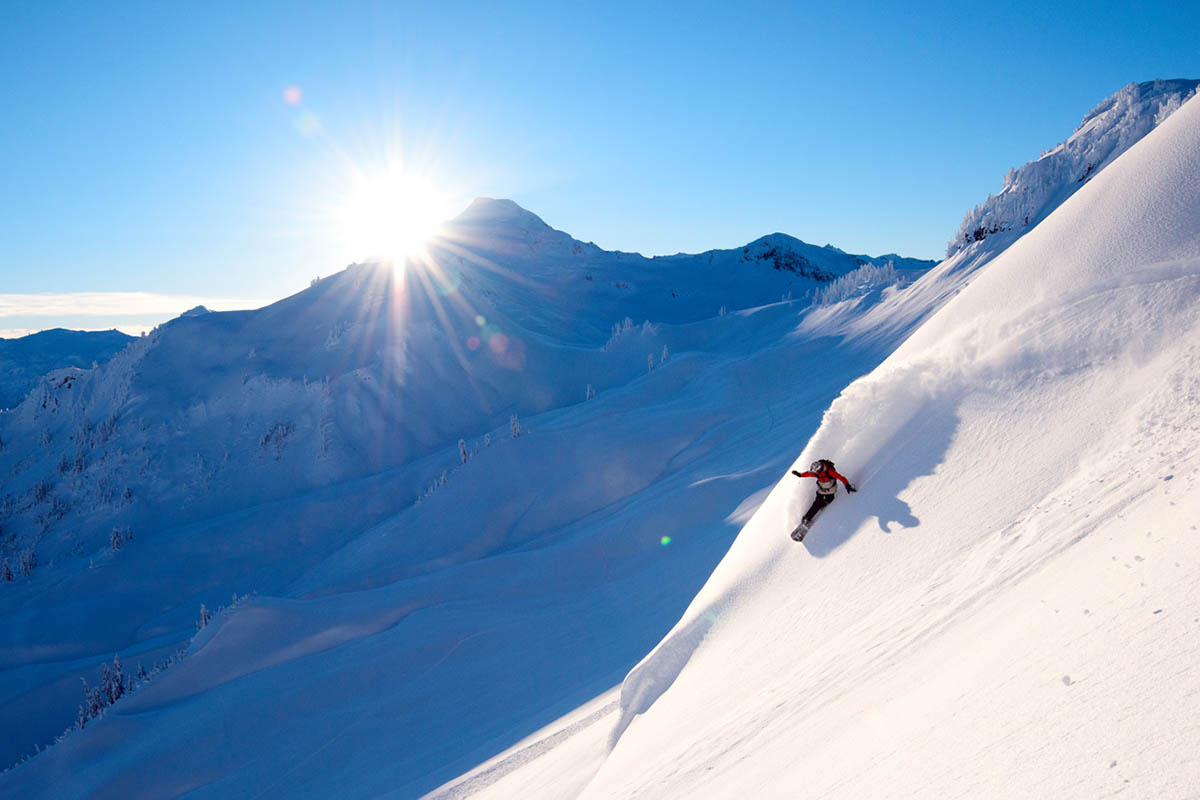
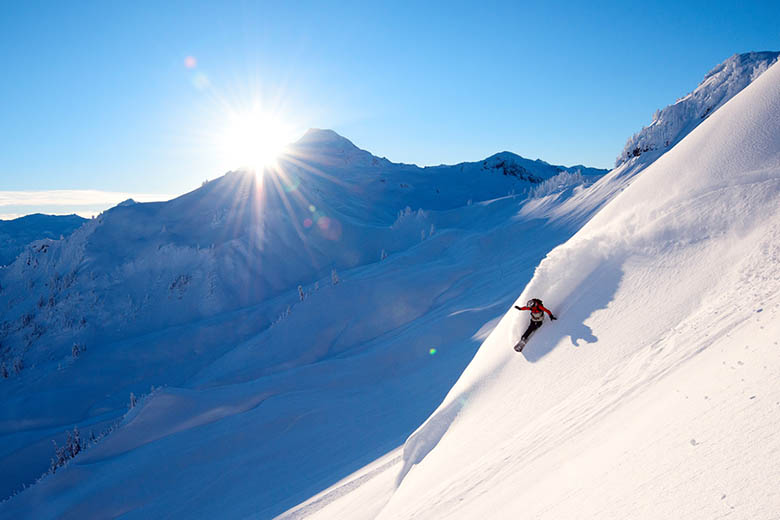
Thanks to a considerable rise in backcountry adventuring of late, splitboarding is having a moment. With the ability to separate your board on the way up and secure the halves together for a true snowboarding experience on the way down, splitboards open up access to untracked terrain and big-mountain objectives. There are a wide range of options to consider, from stiff, mountaineering-focused designs to lightweight carbon and powder-hungry models, and we’ve picked our favorites below for winter 2025. For more background information, see our comparison table and buying advice below the picks.
Editor's note: We updated this guide on January 9, 2025, to revamp our product selection to reflect 2025 offerings. This involved removing a few discontinued boards and updating our coverage and specs for several current models. We also added a section outlining how we test splitboards below the picks.
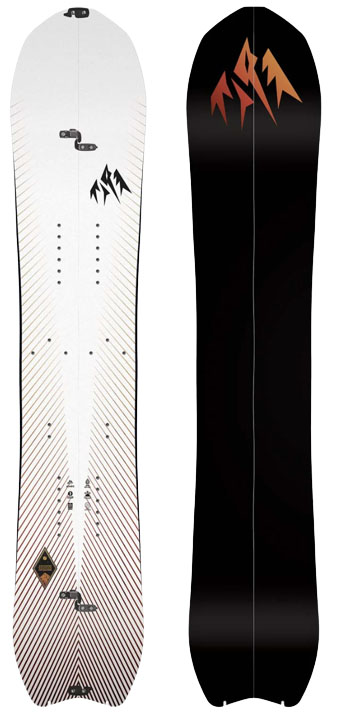 Category: Freeride
Category: Freeride
Flex: Medium
Shape: Directional
Pre-cut skins: Available
What we like: A do-all board from the best brand in the business.
What we don’t: Not the most stable or powerful board for riding steep lines.
It’s a no-brainer to start our list with a Jones splitboard: This Truckee, California-based company sits at the helm of big mountain snowboarding and is one of the most respected brands in the business. Their Stratos is a wonderfully well-rounded freeride board that manages to do everything with aplomb, whether you’re navigating the white room, driving through crud, or popping off a backcountry booter. The board starts off the formula with a directional freeride shape and versatile medium flex and tacks on a short sidecut radius (for fun maneuverability) and a shoveled nose and tapered tail (for buoyancy in deep snow). All told, the do-it-all Stratos is very easy to love and will appeal to intermediate to expert riders alike.
There are a number of boards we could have chosen as our top pick, including a few heavy hitters from Jones’ lineup. But if we know anything about snowboarders, it’s that powder is king (or queen), and a board that can deftly float through deep snow will provide the best experience for most. Jones’ Solution below is another solid option and offers great edge control on firm or steep snow, but its stiff build isn’t as forgiving, and you’ll need to be a decently powerful driver to steer its ship. All told, if you just want to have fun no matter what the terrain provides, the Stratos’ playful and forgiving yet adept personality is our top pick for the 2025 season.
See the Jones Stratos Split See the Women's Jones Stratos Split
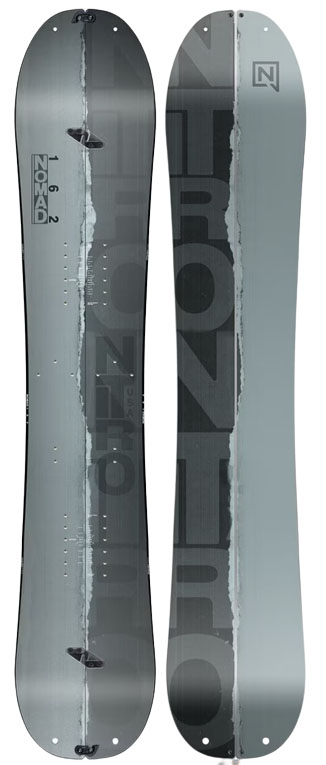 Category: Freeride
Category: Freeride
Flex: Medium
Shape: Directional twin
Pre-cut skins: Available
What we like: Affordable and easy to maneuver.
What we don’t: Soft and flat-cambered design falls short for aggressive riders.
In a market flooded with high-priced splitboards, Nitro's Nomad is a clear standout for those on a budget. Despite being the cheapest option on our list at $580, the Nomad offers competitively well-rounded performance: It's highly durable, pretty stable and forgiving, and comes with pre-drilled holes at the tip and tail for attaching skins (at the time of publishing, you can find sets pre-cut specifically for the Nomad). Finally, while most splitboards have a stiffer flex for more aggressive riding, the Nitro’s softer build is great for beginners and those who like to keep things relatively mellow in the backcountry.
It’s hard to be overly critical at this price point, but the Nomad isn’t for everyone. It’s true that a flat-cambered and slightly rockered profile is great for new riders—the generous effective edge makes turning easy, while the early rise means catching an edge is less likely—but it results in a board that’s slower and less aggressive than most. Tack on the soft flex, and the Nomad isn’t particularly capable on steep terrain or at speed. But the price is right for new or casual snowboarders looking for a playful and reliable backcountry steed. For another reasonably priced board that’s geared more towards powder hounds, check out the Rossignol Sushi below.
See the Nitro Nomad Splitboard
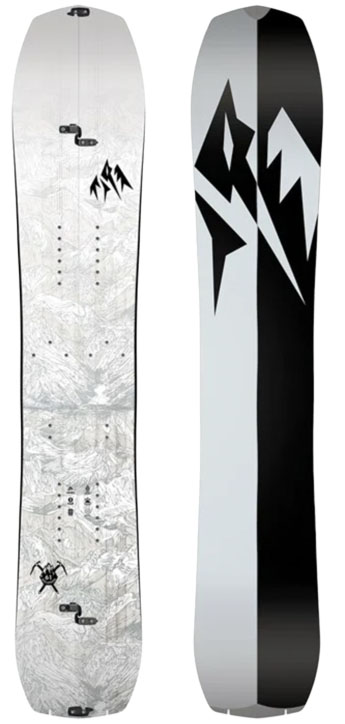 Category: Freeride/mountaineering
Category: Freeride/mountaineering
Flex: Stiff
Shape: Directional
Pre-cut skins: Available
What we like: A powerful board that provides stability in a wide range of conditions.
What we don’t: Not very playful and too stiff for some.
The Stratos above will appeal to the majority of riders looking for a do-all splitboard, but we’d be remiss not to mention the Solution as well. As Jones’ flagship model, the Solution has been around since 2010 and remains one of the most well-regarded and premium designs on the market. In contrast to the Stratos, it has a more serious personality, with a particularly stiff build for power on big steeps and camber underfoot to drive it hard on icy terrain. Recent updates include a more powder-specific shape—including an even balance of spoon bevel at the nose and tail for better float—although the Solution is far from our first choice for deep days. But for advanced to expert riders who aim for big lines, it’s nevertheless a great quiver-of-one option.
The Solution has won more awards than perhaps any other board, but it's not our best overall board for a few reasons. First off, its stiff build will be too much to handle for newer or lighter riders, who will be better off with a softer board like the Jones Frontier and women’s Dream Weaver ($500). Second, as we touched on above, the Solution isn’t our first choice for powder, which is—let’s be honest)—what most snowboarders spend their days sniffing out. But for paramount stability in all manner of conditions, it doesn’t get much better. It’s also worth noting the carbon-infused Ultralight Solution ($1,600), which offers a bump in stability and power with a flex of 10. Jones also makes the Solution in a women’s version, which boasts a similar flex and is available in shorter and narrower sizes.
See the Men's Jones Solution Split See the Women's Jones Solution Split
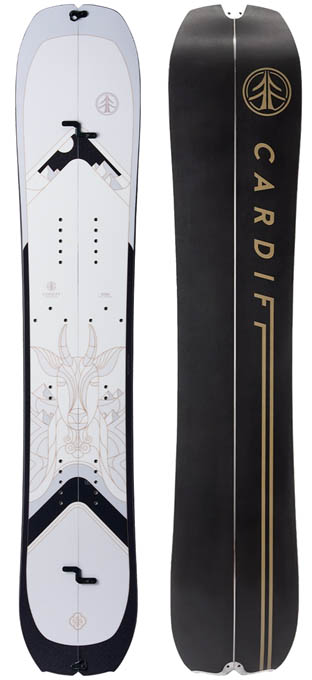 Category: Mountaineering/freeride
Category: Mountaineering/freeride
Flex: Medium-stiff
Shape: Directional twin
Pre-cut skins: Not available
What we like: Directional twin shape is maneuverable and great on the skin track.
What we don’t: Expensive and not as stiff as the Solution above.
With roots in the Wasatch mountains of Utah, Cardiff is a backcountry specialist through and through. In order to appeal to a range of riders, each of their splitboard models is available in Enduro and Pro Carbon variations to customize durability, weight, and stiffness. The Goat here is Cardiff’s premium big-mountain offering, designed for stability and efficiency on the skin track and top-notch performance in a variety of terrain. We especially love the directional twin shape, which is helpful for billy-goating into a line, dipping around rocks, and navigating through tight sections while riding switch. And while the Pro Carbon variation here is ridiculously light at just 6 pounds 4 ounces, less committed riders can save a considerable $400 with the Enduro version (7 lb. 3 oz.).
A board like the Jones Solution (or Ultra Solution) above is also a great choice for mountaineering, but the Goat gets the nod for its exceptional uphill performance (thanks in part to premium details like Cardiff’s Radical Sidecut technology) and versatility for everything from powerful carving to maneuvering tight trees. Weight-wise, the Pro Carbon design is also a significant 12 ounces lighter than the standard Solution. It’s true that Cardiff is a relative newcomer to the scene, but with years of backcountry splitboard riding experience on their team and designs that are built as splitboards first (most companies start with a snowboard and work backwards), this brand is one to watch.
See the Cardiff Goat Pro Carbon Splitboard
 Category: Powder
Category: Powder
Flex: Medium
Shape: Directional
Pre-cut skins: Available
What we like: It doesn’t get much more fun in deep powder.
What we don’t: You’ll need another board for low-tide days.
Put simply, the Weston Japow is a powder hound’s dream. The board features a massive nose and rocker and a stubby swallow tail, perfect for floating the white stuff on the deepest of days. Further, the reverse-camber profile naturally keeps you on your heel, saving you a lot of energy during long stints in pow. And outside of powder, the Japow carves well (even on groomers), and we found it to be more fun than expected in slushy spring conditions too. Few splitboarders will opt for the Japow as their primary board, but for soul riders who want that highly sought-after, surfy feel, it doesn’t get much better.
The Japow is too soft to ride aggressively, and its dramatic swallow tail and set-back stance limit its maneuverability in mountainous terrain. It’s also not the most high-performance choice for the uphill, given the stubby, tapered tail at the end of each ski. But edge hold on the skin track isn’t as much of a concern on pow days, and there’s no hiding the fact that the Japow is decidedly a quiver board. Within this category, the Jones Hovercraft 2.0 (below) is a more well-rounded option that can also charge in firm conditions, but it lacks the nostalgia of a true swallowtail design.
See the Weston Japow Split See the Women's Weston Revel Split
 Category: Freeride/mountaineering
Category: Freeride/mountaineering
Flex: Medium-stiff
Shape: Directional
Pre-cut skins: Not available
What we like: Very fun for a freeride board.
What we don’t: Too soft for powerful carving and high-speed stability.
Venture is a small-scale company out of Silverton, Colorado, with a fairly humble collection of four core offerings, but their boards are well regarded in the splitboard community—and for good reason. This is a classic case of “built by the people and for the people,” and the result is expertly crafted and scrupulously tested boards that show a painstaking attention to detail. The Storm listed here is one of Venture’s most popular designs and features a freeride-focused build for variable mountain conditions and tackling terrain from steep couloirs to tight glades.
With a mid-stiff flex, large (and softer) nose, and rocker profile, the Storm is surfier and more adept in powder than a lot of the freeriding designs here, including the Jones Solution above. In other words, while the Jones offers better chatter control and more stability at high speeds, the Storm is more maneuverable and playful. The differences are minimal, but most splitboarders have spent enough time on a board to understand their riding style, and small variations between models allow you to really hone in on what works best for you.
See the Venture Storm Split
 Category: Powder/freeride
Category: Powder/freeride
Flex: Medium-stiff
Shape: Directional twin
Pre-cut skins: Available
What we like: Playful in powder and great switch-riding ability.
What we don’t: Not super versatile.
The first thing you might notice about Weston’s Hatchet Split is its shape, which features a wide waist and short length (it’s only available in 152 and 156cm models). This fairly unique design makes it noticeably nimble and floaty, perfect for spinning and popping off pillows or running laps in a big powder bowl. The blunted tip and tail and low weight only add to this playful attitude, making the Hatchet easy to throw around and maneuver. Added up, it’s a wildly fun yet capable board for park riders headed into the backcountry.
That said, the Hatchet isn’t much of an all-rounder. As a result of its short and wide build and mid-stiff flex, it’s not the best match for aggressive riding and is too powered-down for carving spring corn or hardpack. It also takes a bit of oomph to get it from edge to edge, and most riders will experience a bit of a learning curve with its wide build. But for freestyle-oriented riders and light and deep snow, it’s a wonderfully playful and capable design. It’s also worth checking out the Cardiff Crane, which features a similar freestyle heritage in a slightly more well-rounded package.
See the Weston Hatchet Split
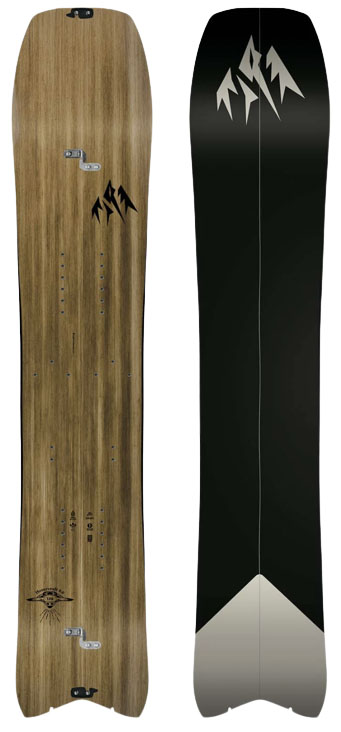 Category: Powder/freeride
Category: Powder/freeride
Flex: Medium-stiff
Shape: Directional
Pre-cut skins: Available
What we like: Fun in powder yet stable at high speeds; short tail is great for jump turns.
What we don’t: Not the most efficient on the uphill.
The Jones Hovercraft is another classic design that has gained a cult-like following over the years. With a massive nose, almost no tail, and a very set-back stance, it’s as directional a splitboard as they come and, as a result, absolutely shines in deep snow. But despite its powder-specific shape, the Hovercraft is surprisingly well rounded: The large nose dampens chatter in firm conditions, and the stiff, blunt tail allows for powerful carving and jump turns in steep and technical terrain. We’ve ridden the Hovercraft in everything from knee-deep powder to steep corn descents off of Cascade volcanoes, and it’s excelled across the board.
The Hovercraft was completely redesigned for the 2024 season, and the 2.0 features a wider nose and 12-millimeter spoon bevel, which translates to both more float and faster turn initiation than the outgoing version. It also tacks on 3D channels at the tail for increased glide. Finally, the Hovercraft 2.0 debuts Jones’ new board recycling program (dubbed Re-Up Tech) with its recycled stringers, which is an exciting step forward in sustainability. Like the first-gen model, the 2.0 isn’t our first choice for freestyle-oriented riders or tight carving, and it does sacrifice some security and speed on the skin track due to its massive nose. But if you’re looking for a playful board for the deep stuff, it’s a great powder-oriented (and now more sustainable) alternative to the Stratos above.
See the Men's Jones Hovercraft Splitboard 2.0
 Category: Freeride
Category: Freeride
Flex: Medium-stiff
Shape: Directional twin
Pre-cut skins: Included
What we like: A durable and easy-to-repair board with free annual waxings and tunings.
What we don’t: Limited selection and some riders won’t love the simple black aesthetic.
Another relative newcomer, PNW-based Season is already in the business of turning heads. While most manufacturers have large quivers that are updated every couple years—practices that can encourage needless consumerism—Season bucks the trend with a sustainability-first, profit-second ethos. Their small lineup includes just five unisex snowboards and one splitboard, most of which feature a fully black topsheet and base that prioritize durability and eliminate the need for an annual freshening up. And true to their commitment to longevity, all of Season’s products also come with a lifetime maintenance plan through Evo for yearly waxing and tuning (plus 30% off repair services and free mounting your first time).
Season’s offerings are the distillation of decades of riding and product design, and the Pass is a capable quiver-of-one companion for a wide range of backcountry conditions. Some might wish for a greater assortment of boards or more vibrant topsheets, but if you’re a recreational rider with no time for decision fatigue, the Pass is about as good as it gets. What’s more, most P-tex repairs are black, which means they blend in, and your board continues to look fresh even after years of use. It also doesn’t hurt that the model we’ve linked to here comes with pre-cut Pomoca skins, which eliminates an extra purchase. Keep in mind that you’ll need to bring your board to an Evo store to take advantage of the yearly waxing and tuning, which might take some planning ahead, but the Pass nevertheless is an enticing value over the long term.
See the Season Eqpt. Pass Splitboard
 Category: Powder
Category: Powder
Flex: Medium
Shape: Directional
Pre-cut skins: Available
What we like: A great value and excellent performance in deep powder.
What we don’t: Not ideal for long tours.
Similar to the Weston Japow above, the Rossignol XV Sushi is a powder surfer’s dream. Designed by hard charger Xavier De Le Rue, the board features a huge rockered nose, stubby swallow tail, and wide waist, which combine to offer incredible float in deep snow. Further, the short build (Rossi only makes the board in one 145cm length) allows for quick turns in tight trees and amazing responsiveness. The Sushi is even more of a niche ride than the Japow above, but since its inception has gained a strong cult following and is still one of the most popular powder splits around.
At $650, the Sushi is one of the most affordable boards here, and its low price tag makes the not-so-versatile design a bit easier to justify. But the short length isn’t for everyone, and since the Sushi’s inception, the market has seen a rush of surf-inspired swallowtails that are arguably just as fun in the white room. But we’ve always found Rossignol boards to be durable, well made, and reasonably priced, and the Sushi is no exception. Powder chasers should also have Spline Snowboards on their radar, a BC-based company that makes well-rounded designs that excel on both the uphill and downhill.
See the Rossignol XV Sushi Split
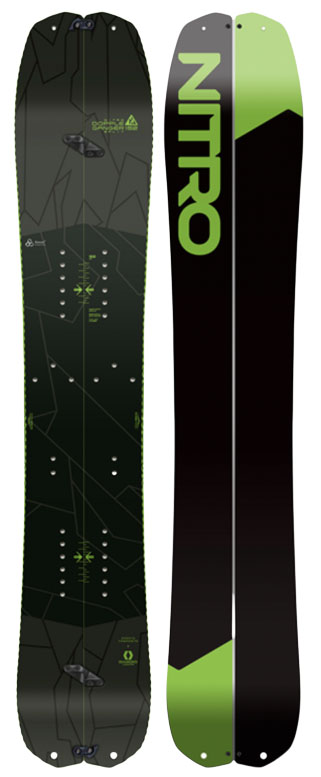 Category: Freeride
Category: Freeride
Flex: Medium-stiff
Shape: Directional
Pre-cut skins: Available
What we like: An affordable and well-built quiver-of-one board.
What we don’t: Not the most high-quality hardware.
Seattle-based Nitro has a growing lineup of splitboards (including a couple women’s-specific models and the entry-level Nomad above), and the Doppleganger here slots in as their top-end freeride design. Checking in at $800, however, it costs hundreds less than the other premium boards, making it an appealing option for bargain-hunters. With a Cam-Out camber shape that nicely balances float and edge grip, 25-millimeter setback, and progressive sidecut, this is a nice do-everything board that can hold its own across variable terrain. You get decent uphill performance, too, with a light, sub-7-pound build and generous edge underfoot for good contact with the skin track.
Putting together a splitboard setup can be time consuming, but Nitro has simplified the process slightly with the option to tack on pre-cut Kohla skins with your purchase (the Doppleganger also comes with pre-drilled holes to easily secure them). You don’t get the same high-quality fit and finish of some of the more expensive boards here—for example, the Doppleganger uses Nitro’s proprietary tip and tail clips rather than more premium Karakoram hardware found on the Jones and Weston boards above. But for new riders or those on a budget, it’s an undeniably good value.
See the Nitro Doppleganger Splitboard
 Category: Freeride
Category: Freeride
Flex: Medium
Shape: Directional
Pre-cut skins: Not available
What we like: A daily workhorse board that’s at home in most conditions.
What we don’t: Only comes in two lengths.
If you’re looking for a daily workhorse regardless of conditions, the Chimera Sceptre might be your answer. Although Chimera isn’t a big name like Jones or Weston, the small Wasatch-based company specializes in splitboards and displays a keen attention to the details. Their Sceptre finds well-roundedness through a subtle directional shape, early-rise nose, and flat camber between the feet, which makes the board float in powder and easy to turn. And with a blunted tip and tail, swing weight is low both on the ground and in the air: Our tester loves this board for everything from arching turns in pow to tight slashes in the trees.
The Sceptre also comes in a carbon-fiber Guide Series model, which is lighter and slightly stiffer than the standard version here. And at just $835, it doesn’t break the bank in the same way that many carbon boards do. Given the standard Sceptre’s medium flex, the Guide Series will be an option for those who often find themselves in icy or variable conditions. Our primary gripe with the Sceptre is that it comes in a limited range of sizes (you only get the option for 158 and 162cm lengths), which isn’t great news for particularly large or small riders. But if you’re in the market for a do-all board from a fun boutique brand, the Sceptre is well worth a look.
See the Chimera Sceptre
 Category: Freeride
Category: Freeride
Flex: Medium-stiff
Shape: Directional twin
Pre-cut skins: Included
What we like: Package deal cuts out a lot of decision-making.
What we don’t: Not a huge cost savings.
Even for very experienced resort snowboarders, switching over to backcountry riding is no small feat. The to-do list can be intimidating—not only do you have to purchase a whole new setup (including skins and poles), but you also need to acquire avalanche rescue equipment and the proper education (including an AIARE 1 course). All that, and you still have to earn your turns. Luckily, K2 cuts out some of the legwork with their Marauder package, an all-in-one deal that gets you a splitboard, mounting pucks and hardware, and pre-cut Pomoca skins for less than some of the pricier models here.
In terms of the splitboard itself, the Marauder features a directional shape with a rockered nose for deep-snow performance and camber underfoot for great responsiveness and grip on the skin track. Further, K2 has been in the snowboard game for decades, and the Marauder boasts the top-notch construction we’ve come to expect from the brand, including features like tip-to-tail carbon stringers for added power without extra rigidity. But in reality, you’re saving more time than money with this package deal. If we assume that skins and pucks will run you a little under $300, the board itself falls around $750, which is about right for the design but not a standout deal. And you’ll still need to buy bindings and poles to complete your kit, both of which K2 also offers.
See the K2 Marauder Splitboard
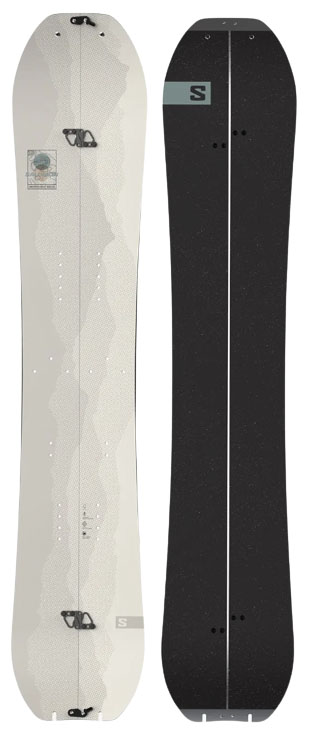 Category: Freeride
Category: Freeride
Flex: Stiff
Shape: Directional twin
Pre-cut skins: Included
What we like: A versatile split built with recycled and sustainable materials.
What we don’t: Not particularly playful.
Salomon’s Highpath splitboard is a primer course in sustainable design. With a recycled base and edges, responsibly sourced wood core, and bio-based topsheet and resin, it leaves little impact throughout both its production and lifespan. But the Highpath is more than just eco-friendly—it’s also a high-performance ripper from a brand that knows its way around hardgoods. Featuring Salomon’s Rock Out Camber and directional tapered shape, the Highpath is a versatile all-mountain split that’s quick to turn and buoyant in powder while still maintaining solid edge control on hardpacked snow.
The Highpath’s stiff build isn’t particularly playful, nor is it ideal for beginners. On the other hand, hard-charging riders who are looking for a confident carver might be disappointed with the Highpath’s dampness at speed, which simply isn’t up to snuff with boards like the Jones Stratos or Venture Storm above. But if you’re an advanced backcountry enthusiast in the market for a versatile and sustainably built ride (or an intermediate rider looking for a board to grow into), the unisex Highpath Split has a lot to offer, and it comes ready to hit the slopes with Plum Hardware and pre-cut Pomoca skins. It’s also worth noting that a number of snowboard brands are now committed to environmentally friendly production, including Lib Tech, Season, Nitro, Wndr Alpine, and more.
See the Salomon Highpath Split
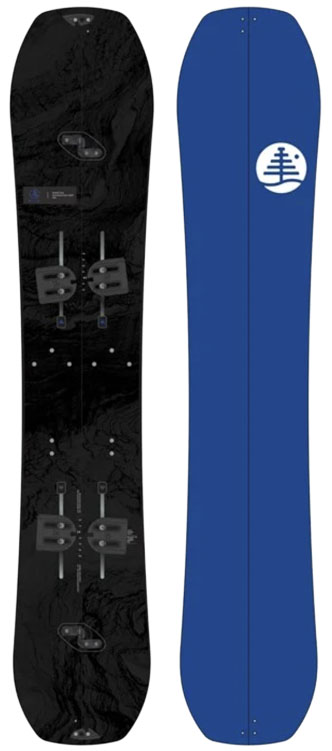 Category: Freeride/powder
Category: Freeride/powder
Flex: Medium-stiff
Shape: Directional
Pre-cut skins: Not available
What we like: An affordable splitboard offering for Burton fans.
What we don’t: Not designed first and foremost as a splitboard.
Burton hasn’t jumped into the splitboarding market quite as readily as some other snowboard brands, but their Family Tree Hometown Hero is a nice option at a reasonable price. Like many of the freeride boards above, the Burton features a directional camber shape, a rockered nose and shorter tail, and a mid-range flex that stiffens towards the front and relaxes towards the back for a nice combination of stability and pop. And to simplify the setup process, we appreciate that Burton tacked on pre-mounted pucks.
Burton tops our round-up of all-mountain snowboards, but their splitboard offerings aren’t quite up to snuff just yet. Companies like Jones, Weston, and Cardiff have put in the time and research to build dedicated splitboards unique from their standard snowboard collections, which reflect the different demands of the sport. Burton, on the other hand, seems to have taken their snowboarding lineup and repurposed some of the models as splitboards (although to be fair, the sport began with snowboarders cutting their boards in half). Those who have ridden Burton boards will appreciate the company’s foray into the splitboarding world, and new backcountry-goers might not notice the difference, but many of the options above deliver better performance and more thoughtful design features.
See the Burton Family Tree Hometown Hero Splitboard
| Splitboard | Price | Category | Flex | Shape | Profile | Pre-Cut Skins |
|---|---|---|---|---|---|---|
| Jones Stratos | $950 | Freeride | Medium | Directional | Rocker/camber/rocker | Available |
| Nitro Nomad | $580 | Freeride | Medium | Directional twin | Rocker/flat/rocker | Available |
| Jones Solution | $980 | Free/mountain | Stiff | Directional | Rocker/camber/rocker | Available |
| Cardiff Goat Pro | $1350 | Mountain/free | Medium-stiff | Directional twin | Rocker/camber/rocker | Not available |
| Weston Japow | $949 | Powder | Medium | Directional | Rocker/camber | Available |
| Venture Storm | $999 | Free/mountain | Medium-stiff | Directional | Flat rocker | Not available |
| Weston Hatchet | $999 | Powder/free | Medium-stiff | Directional twin | Rocker/camber/rocker | Available |
| Jones Hovercraft 2.0 | $900 | Powder/free | Medium | Directional | Rocker/camber/rocker | Available |
| Season Eqpt. Pass | $999 | Freeride | Medium-stiff | Directional twin | Rocker/camber/rocker | Included |
| Rossignol XV Sushi | $650 | Powder | Medium | Directional | Rocker/camber | Available |
| Nitro Doppleganger | $800 | Freeride | Medium-stiff | Directional | Rocker/camber/rocker | Available |
| Chimera Sceptre | $835 | Freeride | Medium | Directional | Flat camber | Not available |
| K2 Marauder | $1070 | Freeride | Medium-stiff | Directional twin | Rocker/camber/rocker | Included |
| Salomon Highpath | $1000 | Free | Stiff | Directional twin | Rocker/flat/rocker | Included |
| Burton Family Tree Hometown Hero | $960 | Free/powder | Medium-stiff | Directional | Rocker/camber | Not available |
In 2025, splitboard technology has evolved far beyond the early days of cutting snowboards in half. Modern designs now prioritize making the uphill trek as enjoyable as the ride back down. Much like backcountry skis, we evaluate both aspects when testing splitboards: For uphill performance, we focus on factors like weight, efficiency, and ease of use; for the downhill, we assess each board's capabilities in a variety of conditions, taking into account its intended use and advertised strong suits. For example, when testing powder-focused boards, we prioritize float in deep snow, while considerations like stability and edge control are more important for freeride models. Elements such as a board’s shape, flex, and profile are carefully considered, as they significantly impact all-around performance.
This guide began in 2021 with 18 boards selected by former senior editor Jenny Abegg, a lifelong snowboarder and backcountry enthusiast, and contributor Sam Kapacinskas, a part-time ski guide and avalanche educator with years of splitboarding experience under his belt. In 2024, editor Maddie Downie took over the round-up, weaving in her perspective as an avid backcountry skier and former snowboarder. We also rely on insights from trusted contributors and the wider snowboard community to inform which designs make our list each season. Rest assured: We will continue putting new and noteworthy splitboards to the test, refining the picks above to reflect the latest and greatest.

Put simply, a splitboard is a snowboard cut in half lengthwise, which allows backcountry riders to use the two halves as skis to travel uphill and reassemble them to ride as a traditional snowboard on the descent. Due to the relative newness of the sport, splitboarding comes with some unique challenges: Transitioning from the uphill to downhill is time-consuming, traversing in tour mode can be difficult, and you have considerably less versatility and efficiency than with skis (especially on long, flat sections). But for many snowboarders, the rewards of untracked powder, solitude, and earning your turns is well worth those downsides. And the good news is that splitboarding gear is still in its infancy and seeing massive improvements year after year.
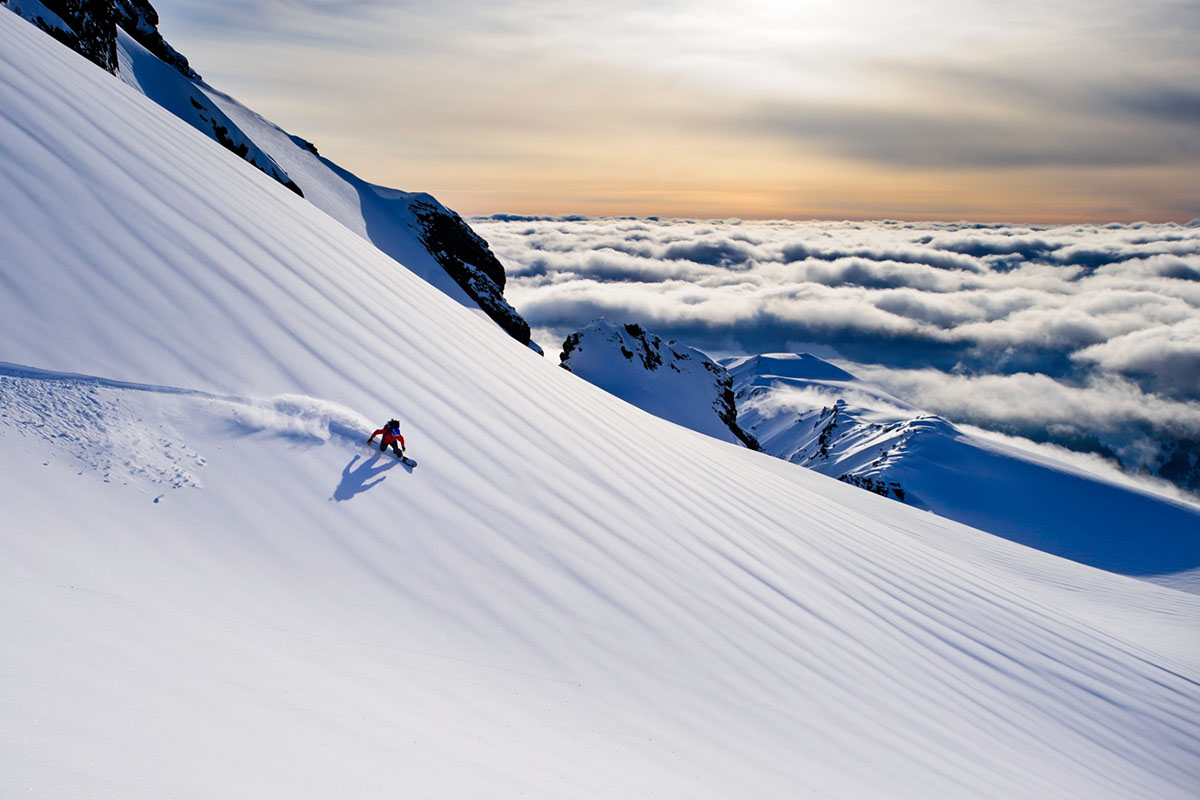
Broadly speaking, splitboards are very similar to traditional snowboards in their materials and core technologies. They also feature an additional metal edge on the inside of each plank, which provides extra traction on the skin track. Further, all splitboards come with preinstalled split hooks and clips at the tip, tail, and body that allow you to attach and separate the two halves. You’ll also find two sets of mounting holes on a splitboard: one for bindings in ride mode, and the other for bindings in tour mode. With all the added tech, splitboards generally run around $200 to $500 more than standard snowboards, but most modern models are so well engineered that you’ll feel little to no difference when bombing downhill.
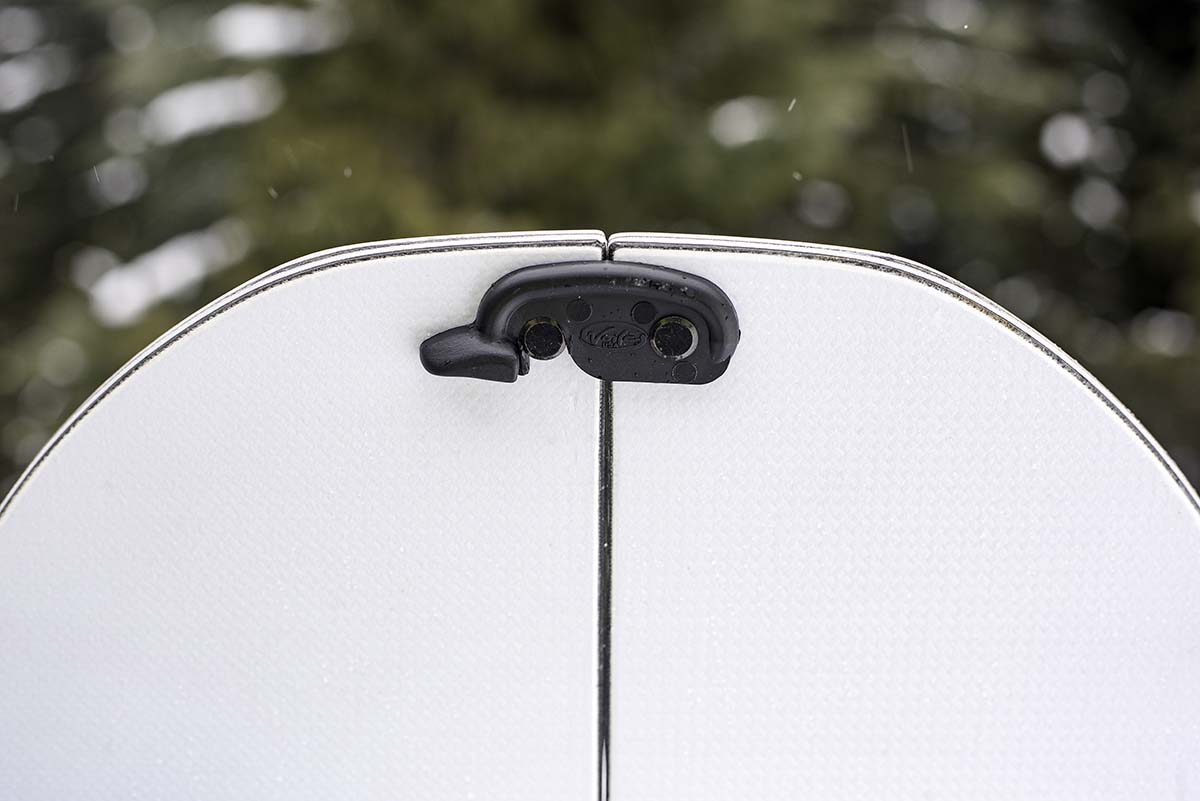
Freeride
The most versatile style, freeride splitboards are quiver-of-one boards built to handle a variety of terrain, including deep powder, spring corn, and big-mountain lines. Common features in this category include a mid-stiff flex for stability on steep terrain, a directional twin shape with a significant setback, and a rocker profile that prioritizes float over speed and edge control. Freeride boards come up a bit short on the deepest powder days and aren’t always top performers on the skin track, but they’re far and away the most versatile option and our top choice for most riders. Some of our favorite freeride designs include the Jones Stratos, Season Eqpt. Pass, and Nitro Doppleganger.
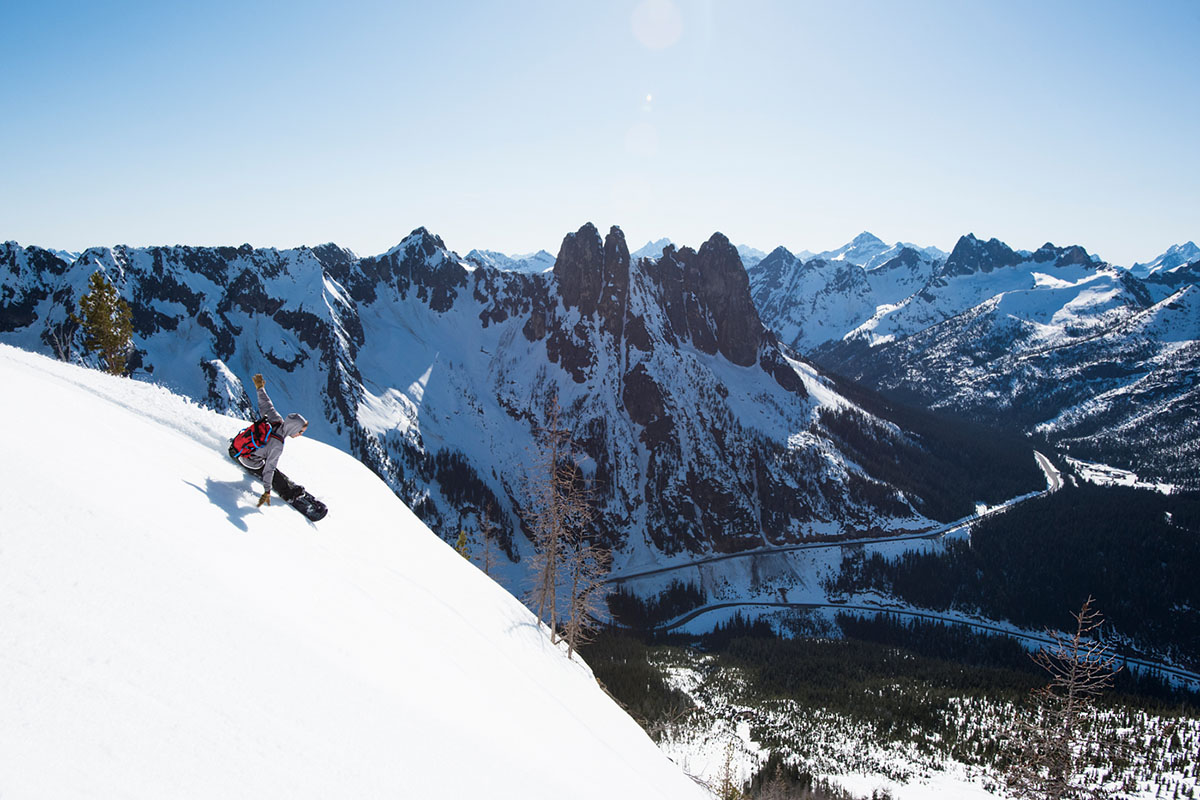
Mountaineering
At the premium end of the spectrum, mountaineering models are built for maximum performance in technical backcountry terrain and nicely balance uphill and downhill capabilities. These boards are defined by their directional shape, rocker/camber profile for maximizing both float and edge grip, and stiff flex ratings that give you the ability to charge hard in high-consequence terrain (some mountaineering boards will have more of a directional twin shape, making it easier to drop into a big line switch). They’re also stable and efficient on the uphill, with lightweight builds (often carbon) and premium edge designs for hold on icy, traversing skin tracks. As a result of all this tech, splitboards in this category are some of the most expensive on the market, but the cost is worth it for intermediate to expert riders hoping to get the most out of their ride in consequential terrain. Our favorite mountaineering designs this year are the Cardiff Goat Pro Carbon Split, Jones Solution, and Venture Storm (and Storm Carbon).
Powder
The quest for deep powder brings many a rider to the backcountry, and an aptly named powder board is the best tool for the job. Powder-focused splitboards are characterized by their large, rockered noses, set-back stances, wide waist widths, and tapered tails. Some modern powder boards are built extra-wide and short—like the Weston Hatchet—while many old-school options are built with a wide nose and have a very large swallow tail that reduces friction and keeps the nose afloat (like the Weston Japow). Keep in mind that most powder boards don’t offer great versatility. In other words, they shine in deep conditions (and sometimes corn) but sacrifice performance in variable snow, and particularly on ice.
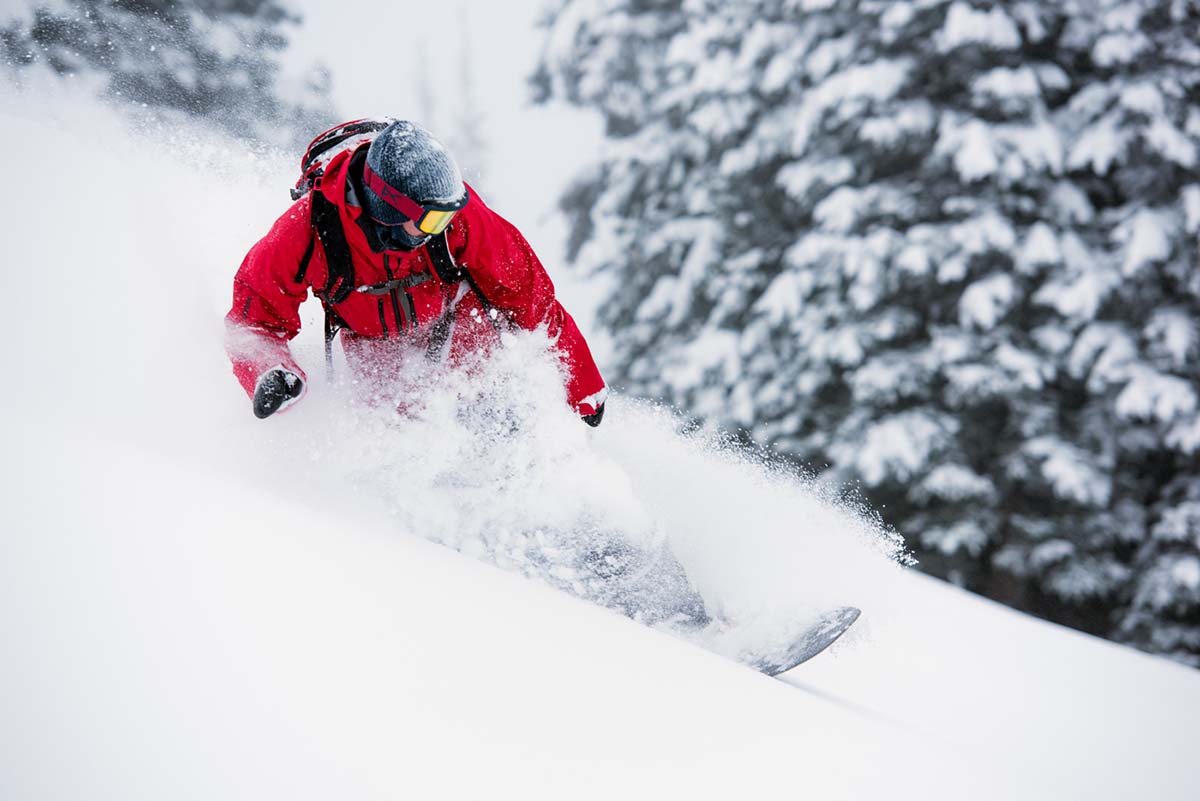
One of the trickiest factors in selecting a splitboard is finding the right balance between uphill and downhill performance. In the end, this will come down to your individual goals as a splitboarder. Do you want to prioritize speed and efficiency on the skin track, or would you rather have stability and power on the descent? As we outline below, a splitboard’s performance both on the uphill and the downhill is a function of multiple factors, including weight, width, profile, and shape.
As with skiing, weight is a primary factor for uphill-focused riders embarking on long tours or multi-day trips. Carbon tends to be strong and stiff while keeping weight low, which makes it a common (and expensive) material used in lightweight designs. But weight isn’t the only factor here—you’ll also want to look for a mid-to-narrow waist (opting for an overly wide board will mean breaking trail even on the skin track), a camber profile for good control while traversing icy slopes, a relatively long length for ample flotation, and a stiffer flex for stronger ski performance when split skiing. In general, mountaineering boards are the best options here, especially those designed particularly for uphill travel like the Cardiff Goat Pro and Jones Solution. We’ve found that powder boards like the short and wide Rossignol XV Sushi Split are notably poor performers on the uphill, which is in large part due to their softer flex, rockered profile, and heavier weight.
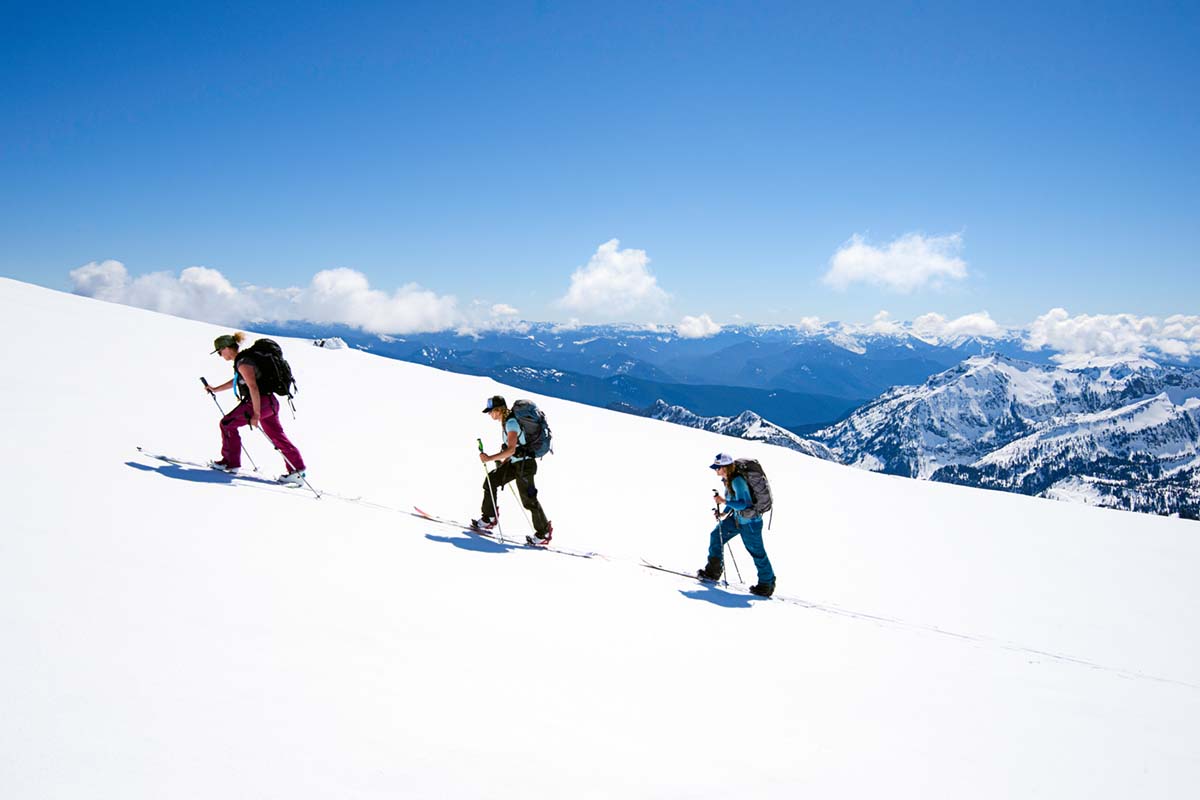
As always, however, there are some inherent tradeoffs in opting for an uphill-focused splitboard. First, these boards can be too stiff for some riders, and shaving weight can sometimes result in a lack of durability. Many splitboarders will find that these designs also lack the “surfy” feeling that drew them to splitboarding (rather than skiing) in the first place. Further, carbon boards like those mentioned above can run you over $1,000, and that’s before tacking on bindings, boots, and skins. As a result, all but the most discerning and weight-conscious splitboarders will likely prefer the boards in our freeride category, which often strike a nice middle ground between up- and downhill abilities.
Splitboard Shape
Splitboards come in a variety of shapes, which can be broken down into three main styles: directional, true twin, and directional twin (or semi-twin). The shape of a board is a key indicator of the style of terrain it’s built to handle and often correlates with the freeride, powder, and mountaineering categories above. Powder boards, for example, are directional and generally feature large noses and small tails, while freeriding boards are closer to a true-twin shape, which lends great versatility for switch and freestyle riding.
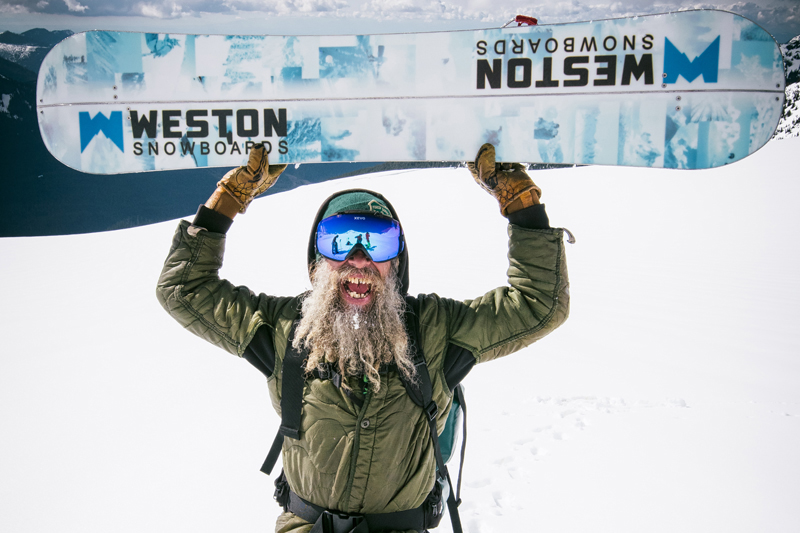
As the name suggests, directional boards are designed to be ridden in one direction. These boards often feature set-back bindings, larger noses, and small, stiff tails (some powder-specific models sport a swallowtail for a surf-like feel in soft snow). Boards with a directional shape are generally built for stability and carving at speed and are popular in the powder category. True twin boards, on the other hand, are symmetrical at the nose and tail (generally both in shape and rocker/camber). Popular among freestyle snowboarders, this shape is great for riding switch but lacks power and stability at speed and in deep powder—as a result, true twin splitboards are not popular among backcountry snowboarders. Finally, directional twin (or semi-twin) boards combine the strengths of both styles, with a nearly symmetrical shape and slightly longer front end that are great in powder and variable conditions. Their well-rounded nature makes directional twins the most common shape among splitboards, seen in models like the Cardiff Goat Pro Carbon and Nitro Nomad.
The width of a splitboard’s waist also plays a big role in its on-snow performance. In order to increase floatation, powder boards will often have wider waists, while most freeride boards are narrower for less chatter and more control at speed. And width matters on the uphill too: The narrower your plank is, the more control and stability you’ll have on steep traverses and icy terrain. On the flipside, with a board that’s overly wide (like the powder-focused Weston Hatchet), you’ll feel like you’re breaking trail even when you’re on an established skin track.
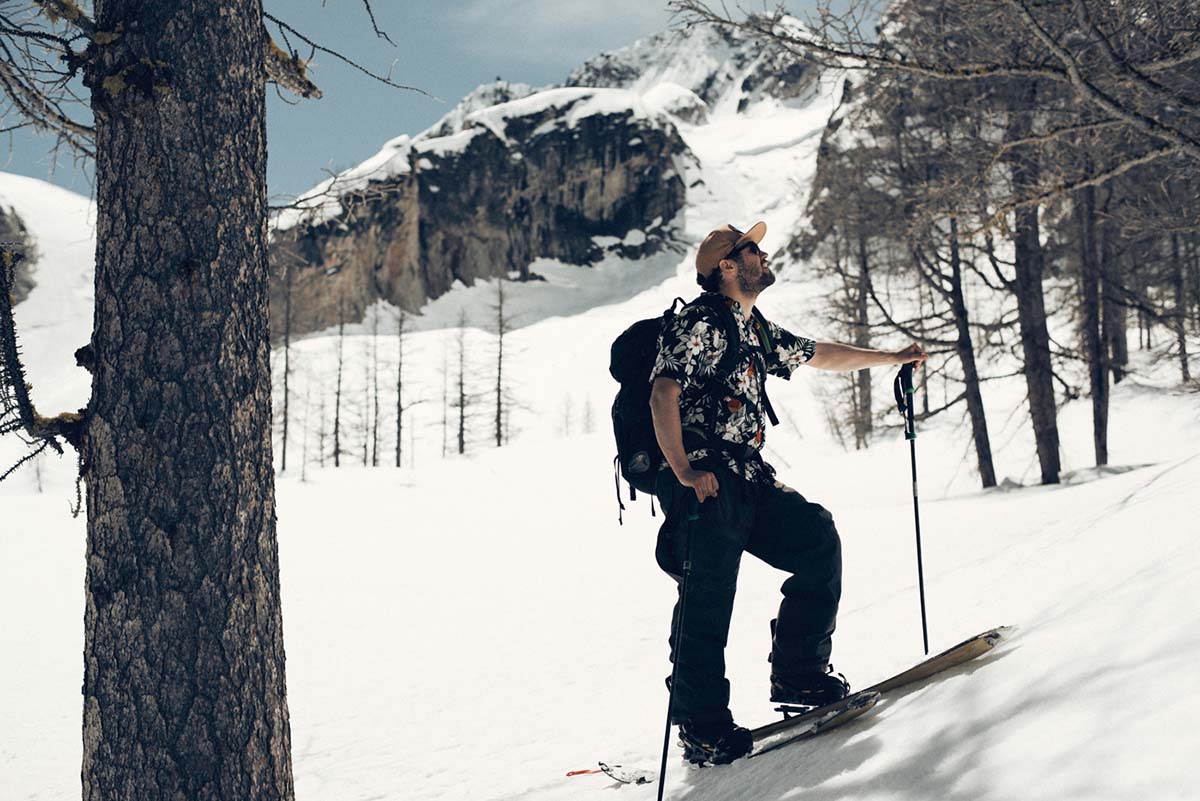
Sidecut Radius
We won’t dive too deep into the nitty gritty here, but sidecut is a measurement of what size circle would result from the arc created by a splitboard’s design (similar to a vehicle’s turning radius). In general, a splitboard with a narrow waist width compared to its tip and tail will have a shorter sidecut radius, while a board with a wider waist will have a longer sidecut radius. A board with a short sidecut (5 to 6m) will have an easier time making snappy, narrow turns but can struggle at higher speeds, while one with a longer sidecut (8m and above) will prefer wide, arching turns and offer better stability when going fast (at the sacrifice of maneuverability).
As a very general rule of thumb, mountaineering boards have a long sidecut, freeriding boards have a short-to-medium sidecut, and powder boards fall somewhere in between (although often shorter than longer). However, there are many exceptions to the rule: for example, a powder board that is meant to be more aggressive may have a longer sidecut for high-speed, arching turns, while a powder board designed for riding mellow trees may have a shorter sidecut for making quick, snappy turns.
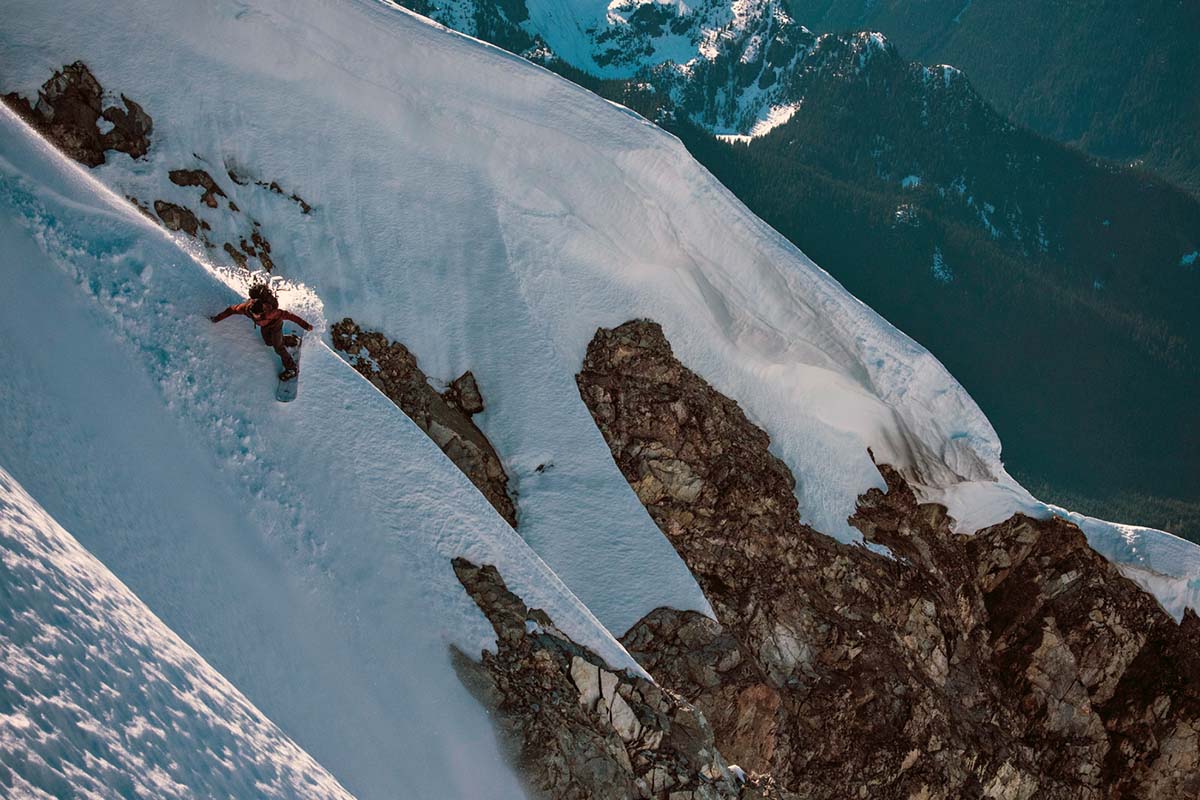
Splitboard Flex
Another key consideration is the flex or stiffness of your splitboard. Most boards are rated on a 1 to 10 scale, with 1 being a soft, freestyle-oriented board and 10 being a stiff, high-end mountaineering design. Others are simply designated as soft, medium, or stiff (and sometimes a mix). It’s important to note, however, that ratings are not standardized across the industry and can vary significantly from one brand or board to another.
Most splitboards fall into the medium-to-stiff flex range, or about 5 to 8. Softer boards allow for easy flex and a quick response when turning, but they tend to get “chattery” at high speeds and struggle in variable terrain (which is often what you’ll find in the backcountry). Stiffer cboards, on the other hand, are great for charging big lines and maintaining control, although they can be challenging to turn and are not very nimble in tight spaces. For big-mountain pursuits and mountaineering, we recommend a stiffer design like the Jones Solution, while many will prefer a medium flex (like the Cardiff Goat Pro or Weston’s Hatchet) for Japan’s pillows or Colorado’s tight aspen trees.
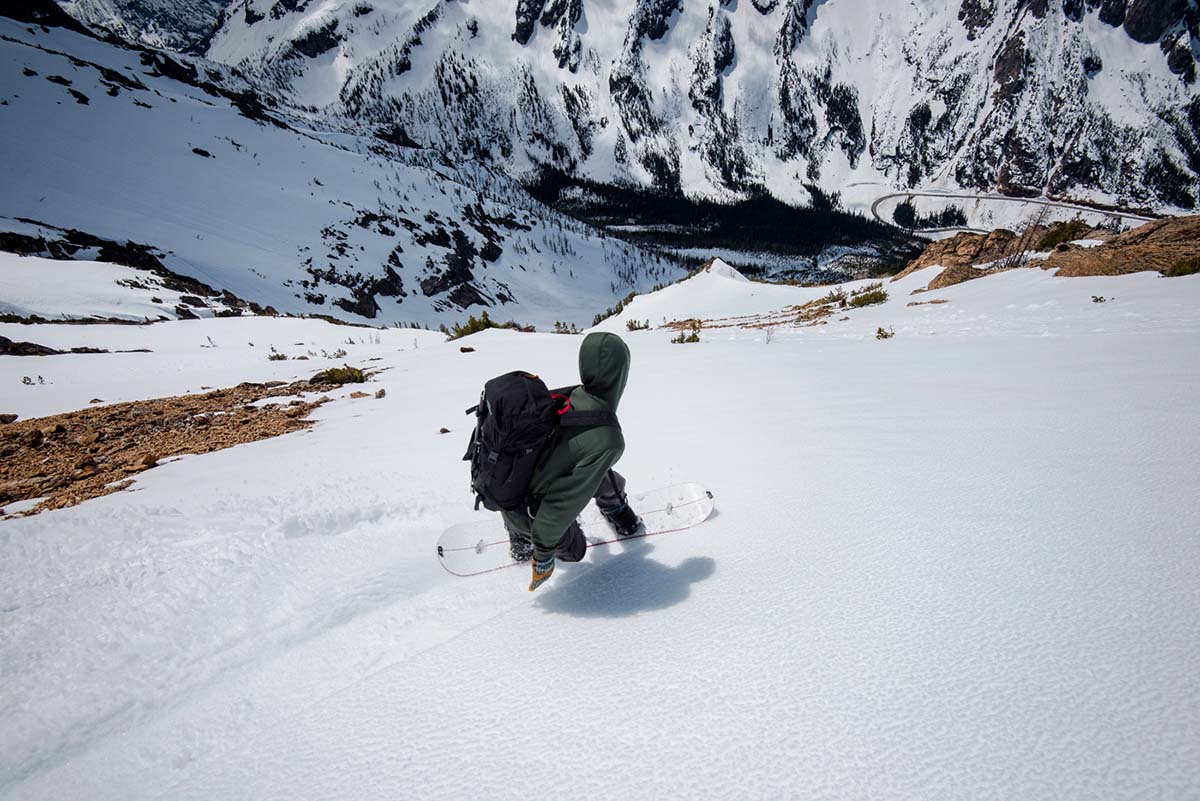
Splitboard Profile
Understanding a splitboard’s profile—that is, its rocker, camber, or a combination of the two—is an important aspect in choosing the right model for you. The classic design is a camber profile, which features a high point between your feet and a gentle bow down toward the tip and tail (imagine a rainbow). Camber advocates like the aggressive snap you get when initiating a turn, but the flipside is that the board takes a lot more power to control and often turns slower than other profiles.
On the other hand, a rocker profile is flatter between your feet and bows up at the tip and tail (like a banana). These boards initiate turns quickly and float in powder with ease, but the tradeoff is that you get less stability at high speed and more of a chattery feel. And a third style is a combination of rocker and camber profiles, which—when executed well—manages to provide an excellent balance between the two. Each brand has their own take on this concept, but it often involves camber between the feet and rocker at the nose and tail. With this profile, you get both snappy turns and stability at speed.
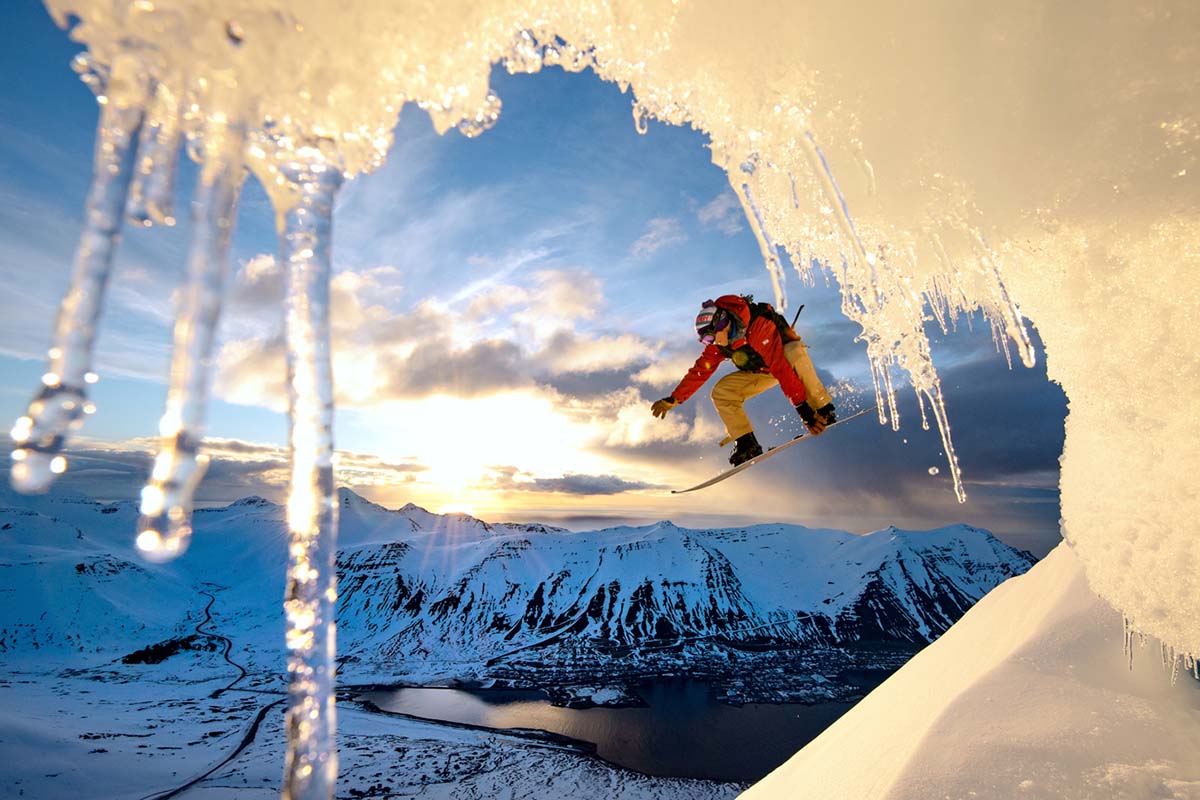
When deciding on the profile of your board, it’s important to consider your uphill objectives too. Contact points with the snow are crucial for maximizing traction on the skin track, especially when traversing steep slopes or climbing icy terrain. A heavily rockered splitboard will struggle to maintain grip, while a cambered board (or a mix of camber and rocker) maintains a much wider surface area with the snow and will be more efficient on the way up. For this reason, most splitboards feature a camber profile or a combination of both camber and rocker underfoot.
Setback
To understand setback, let’s first consider a true twin snowboard. In most cases (although not all), the bindings will be centered on the middle of the board, with an equal amount of distance between the center and the front binding and the center and the rear binding. This is referred to as a “centered” stance, or zero setback. As we move the rear binding back, the setback increases (measured in terms of distance from a centered stance and often expressed in millimeters). Looking at the setback of a board is a great way of determining its intentions and the style of terrain it’s designed to ride. In general, the more setback your stance is, the more float you’ll have in powder. Less setback, and you get a more playful, freestyle-feeling board that can easily ride switch.
In most cases, a board’s setback correlates with its shape: Most true twins will be centered, while directional boards will have the largest setbacks (and directional twins are in the middle). For example, powder boards like the Rossignol XV Sushi have dramatically set-back stances, while more all-around directional twin splitboards might be set back 15 to 25 millimeters to maintain performance for a variety of terrain and riding styles. Board shapers can get creative with this too, by combining a centered stance with a directional twin shape (as in the case of the Weston Hatchet) for performance in both powder and freestyle riding. Finally, keep in mind that a board’s setback generally is fixed with its profile so that the feet are centered around a rocker or camber in the middle. For this reason, we don’t recommend altering your board’s setback (unless you really know what you’re doing).
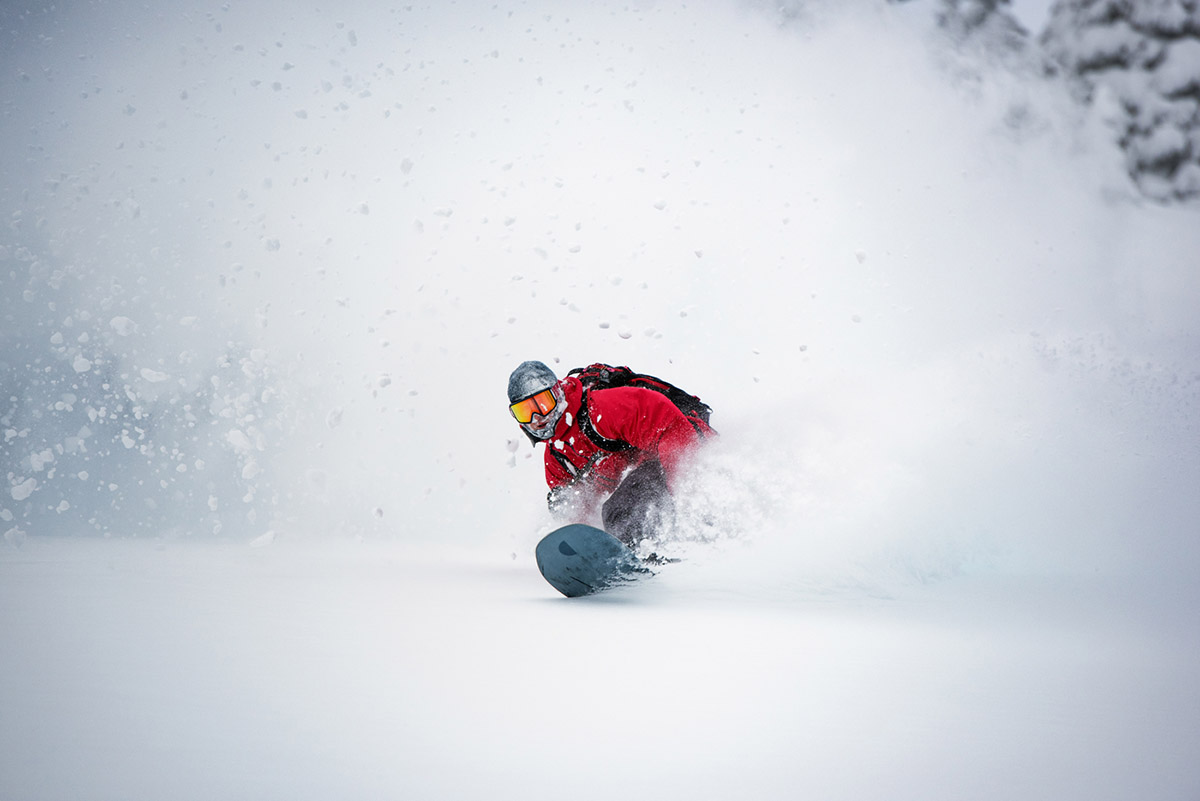
Splitboard lengths range from around 145 to 170 centimeters, which is a lot less dramatic of a range when compared to skis. However, finding the right length for your weight, stature, and riding preferences nevertheless is crucial for maximizing performance. Manufacturers and retailers provide recommended size charts for each of their models, but in general you’ll want a longer board for aggressive downhill carving and a shorter design for freestyle riding and maneuverability. Some powder boards feature a shorter length, but be mindful that too short of a board will sacrifice some uphill efficiency.
In terms of width, when sized correctly, your boots should hang over the edges of the board but not touch the snow while you’re edging. Those with larger feet will want to look for a wide board, which is often indicated by a “W” after the length (for example, 165W). Manufacturers often publish helpful info on when to size up to a wide board, which is commonly around an 11 or 12 for men and 9 for women (women who need a wider model can also consider regular-waisted men’s versions). And as we’ve mentioned above, a splitboard’s width is an important factor to consider when it comes to uphill travel too. For the best stability on the skin track, we recommend sticking with a regular-waisted version unless sizing up is absolutely necessary.
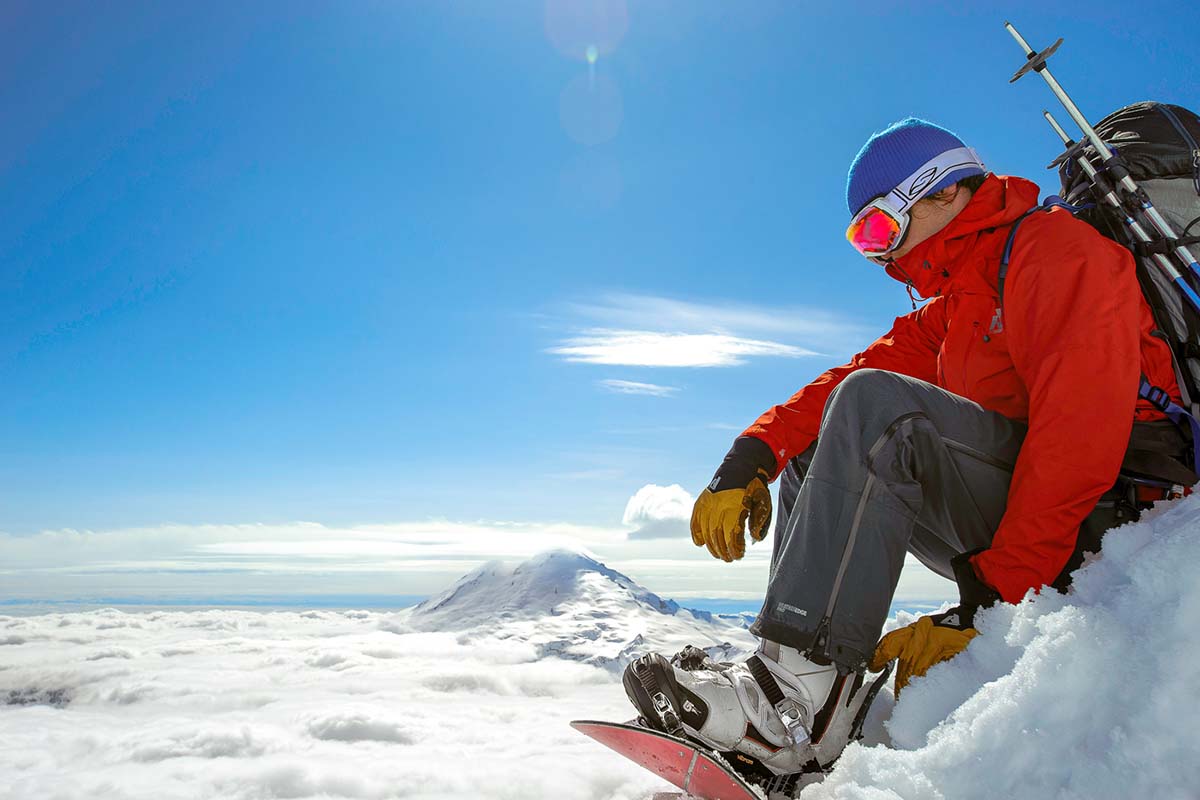
The splitboards on our list range from just under 6 pounds to over 8 pounds (without bindings), with the majority of models clocking in around 7 pounds. While splitboards generally have less focus on weight-cutting than backcountry skis, it does become important if your objectives entail hauling your setup far into the backcountry. If you’re looking to cut weight, look for a board that utilizes carbon and weight-saving technology in the core (our mountaineering category is a great place to start). You’ll pay a premium for these ultralight designs—the Venture Storm Carbon, for instance, is $300 more than the standard Venture Storm—and carbon boards can be overly stiff, but for long tours and multi-day mountaineering objectives, those ounces add up quickly.
Nowadays, modern women’s-specific splitboards are much more than just different-colored and smaller versions of their men’s counterparts. The best women’s boards take the female body into account with narrower widths (women generally have smaller feet relative to their height than men), shorter lengths, and softer flexes to pair with lighter frames. That said, some companies have begun taking a more wholistic approach to their lineups, doing away with gendered boards and instead offering unisex models in various sizes and flexes. When looking at the list above, we invite you to shop based less on your gender and more on what you know about yourself as a rider, including your body type, riding style, and desired board experience. And if a certain model appeals to you, it's often the case that the company makes a similar board with a slightly softer or stiffer flex.
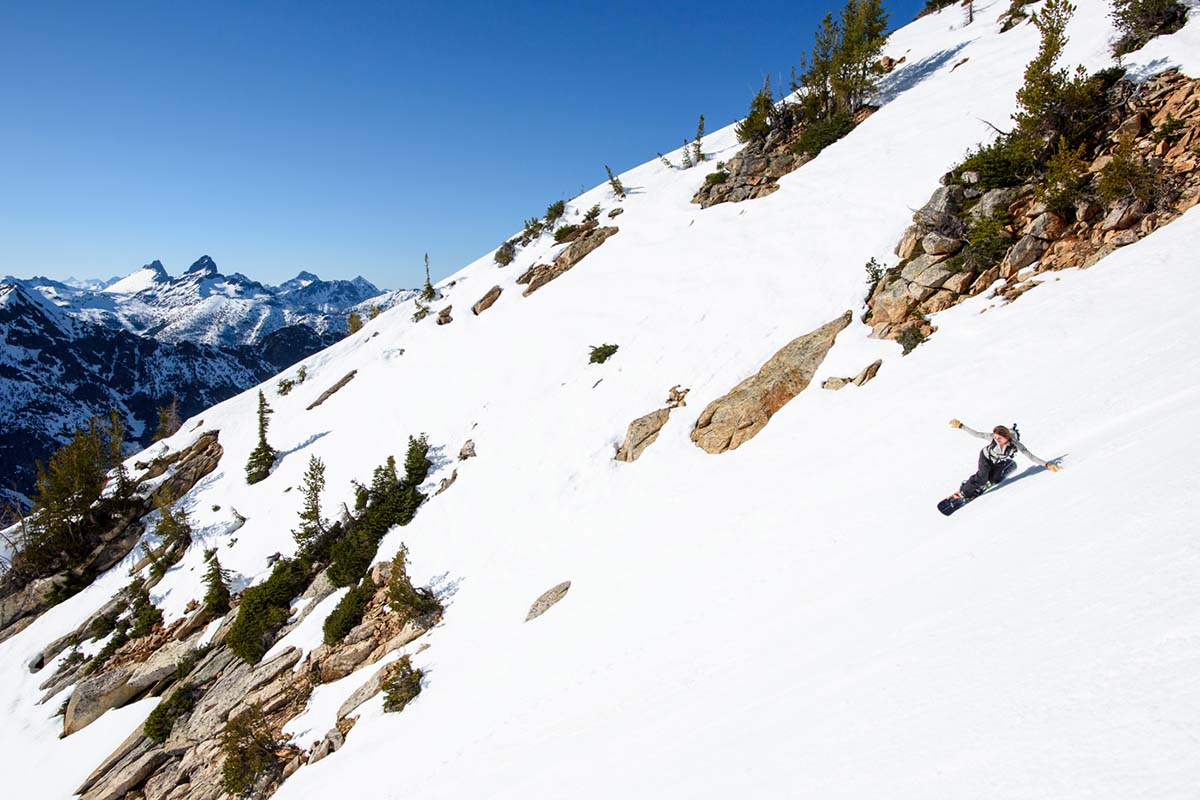
Climbing skins adhere to the bottom of your two planks by way of glue and toe and tail clips, allowing you to grip the snow as you slide uphill. The majority of skins are made either with nylon, mohair, or a mix of the two—nylon is heavier, more durable, and offers a more secure hold, while mohair is lighter and faster on the skin track. For most backcountry explorers we recommend a nylon/mohair mix, also known as momix, although nylon skins are perfectly passable for beginners.
Because skins’ original (and still most popular) application was in backcountry skiing, most splitboarding designs are made by ski companies like G3, Black Diamond, Pomoca, and Contour. It’s also common for board-makers to partner with these manufacturers to help expand their offerings—for example, Jones’ branded skins are made by Pomoca, while Nitro and Karakoram’s skins are made by Kohla. Most skins are compatible with a wide range of splitboards and must be trimmed to fit your specific model (this is a fairly easy DIY process). On the other hand, some brands offer custom designs for specific boards—no cutting required. The Nitro Nomad skins, for example, are available in multiple models depending on the size and style of your Nomad board. And finally, some boards—namely the Salomon Highpath, Season Pass, and K2 Marauder—include pre-cut skins with purchase.
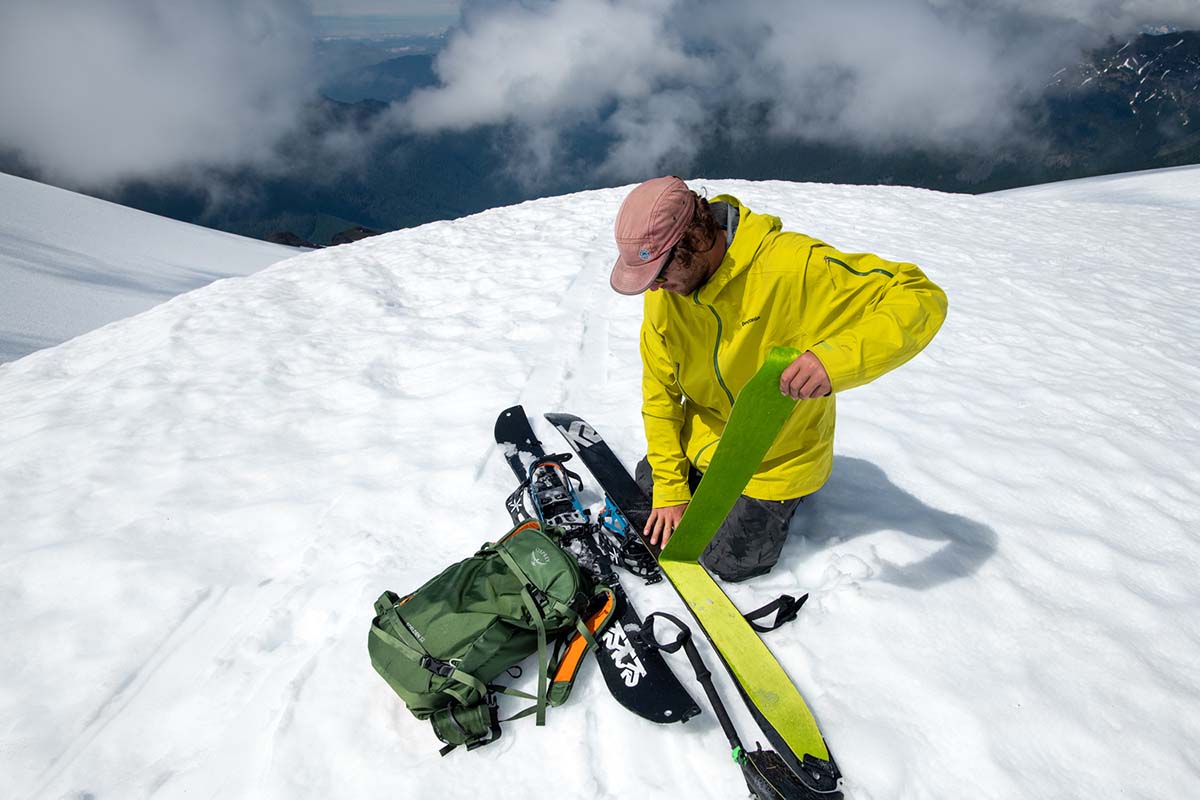
Splitboard Boots and Bindings
Some aspects of splitboard technology are still far behind the ski industry, and boots are one glaring example. The market in 2024 still is fairly limited, and most splitboarders end up using their inbounds boots for touring (our favorite is the relatively stiff K2 Aspect), which are comfortable yet offer limited performance for steep traversing, kicking steps, and pairing with crampons. As a result, some splitboarders turn to ski boots (Phantom is one of the only companies that makes splitboarding-specific hardboots), but these come with a few major downsides, and we only recommend them for mountaineering missions. If you’re on the hunt for a quality pair of boots (we’re sure more and more will continue cropping up), look for design features like crampon compatibility, solid toe boxes for kicking steps, the ability to adjust the upper and lower boot separately, heel lock-down technology (important for minimizing blisters at the heel), and a low weight.
In terms of bindings, there are two main styles to choose from: softboot bindings and hardboot bindings (the vast majority of splitboarders opt for the former). Splitboard bindings offer increased range of motion for uphill travel, are generally lighter-weight and more durable than standard snowboard bindings, and are compatible with splitboard mounting hardware. They also include backcountry-specific features like the ability to lock your heel in to skate and heel risers for more efficient climbing. If you want to save money, it is possible to use your standard snowboard binding and pair it with Voile’s Slider Track, although this setup is fairly heavy, clunky, and won’t offer the best performance.
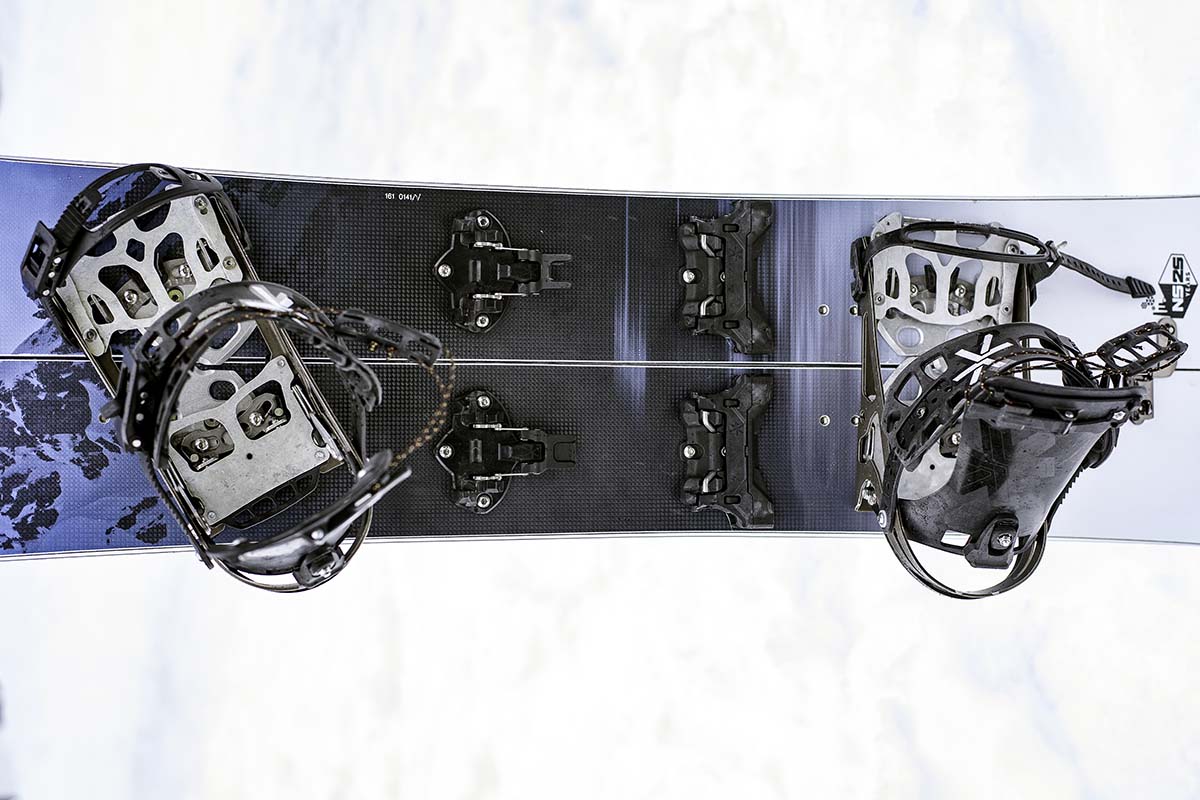
In terms of mounting hardware, you have a few options. The most popular system is the classic puck, which mounts to your splitboard and allows you to slide your binding on or off (we like Spark R&D’s Spark Pucks for their durability and simplicity). Other splitboarders favor the Karakoram system, which includes both an interface and a binding. Unlike the puck style, Karakoram’s interface pulls the two boards together in addition to securing your binding, which Karakoram claims improves ride quality and makes transitioning your binding to ride mode easier with self-clearing snow removal. Karakoram bindings also have the ability to switch from ride mode to tour mode while staying on your feet, which eliminates a step in the transition process.
Other Splitboarding Essentials
In addition to a splitboard, bindings, boots, and skins, you won’t be able to get very far into the backcountry without a number of other essentials. First and foremost is your avalanche safety gear, which includes a beacon, shovel, and probe, plus the ability to use them properly and efficiently (for more, see our section on avalanche safety below). Second, a set of poles is key, and you’ll want a durable and collapsible model that’s strong on the uphill but can disappear into your pack on the way down (we love the MSR DynaLock Ascent Carbon). To carry it all, we recommend purchasing a snow backpack with backcountry-specific features like a dedicated avalanche-tool pocket, external ice axe and pole carry, straps for securing a snowboard, and oversized zippers for easy manipulation with gloves.
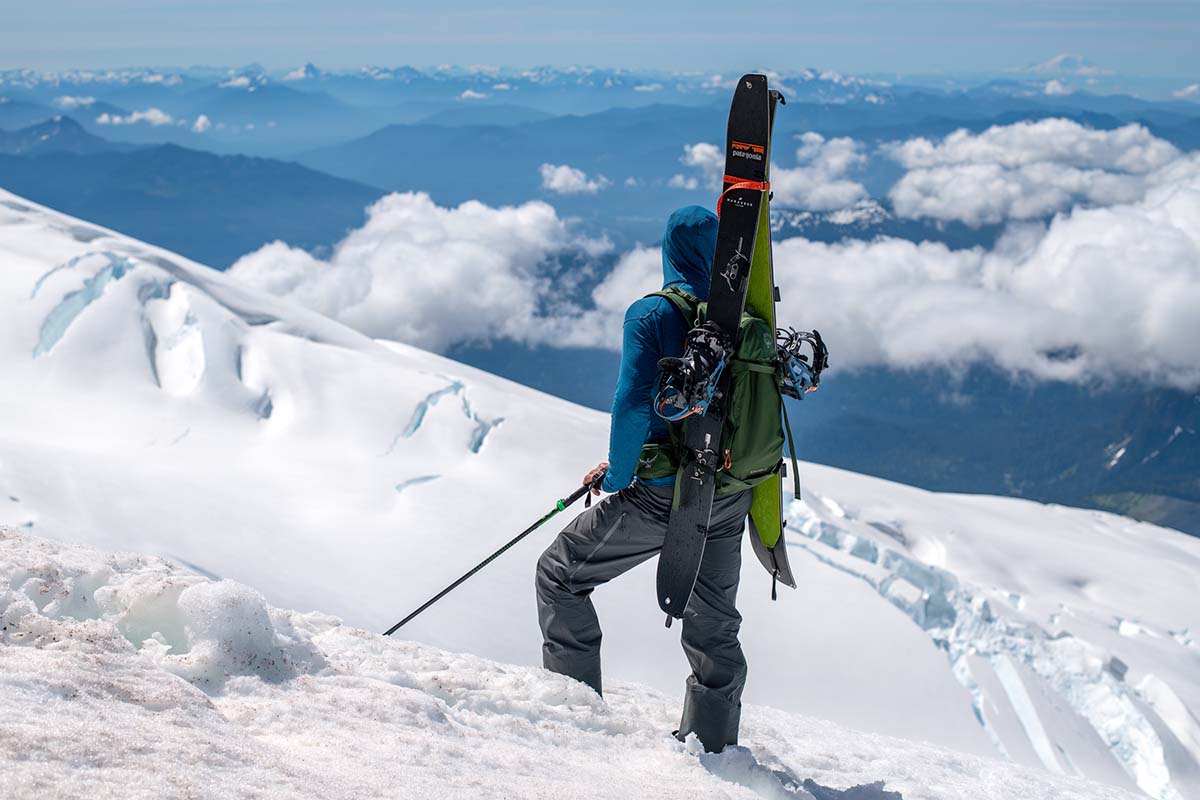
Before you go all-in on a splitboarding setup, it’s worth considering all your options. Many riders start with a standard snowboard, strap it to their pack, and use snowshoes to tackle the uphill. However, while this works for recreational snowboarders and those who only tour a few times a season, it's not a great long-term option. Snowshoeing is physically challenging on long days, slower than skinning, and oftentimes requires breaking trail next to a nice, packed-down skin track (you don’t want to ruin the track for others by snowshoeing in it). Choosing a splitboard for the uphill is far more efficient and allows you to cover more mileage with far less effort.
For DIYers, there’s also the option of cutting an old snowboard in half and drilling dedicated holes for splitboarding hardware. Voile sells their Split Kit for this exact purpose ($170), which comes with all the parts you’ll need to convert an old board, as well as step-by-step instructions. But while splitting an old board may seem like a cheap way to get into an expensive sport, we don’t recommend it from a performance standpoint. Having ridden many DIY splitboards, we’re confident in saying that they’re hard to build, sloppy to ride, and end up costing more than you expect.
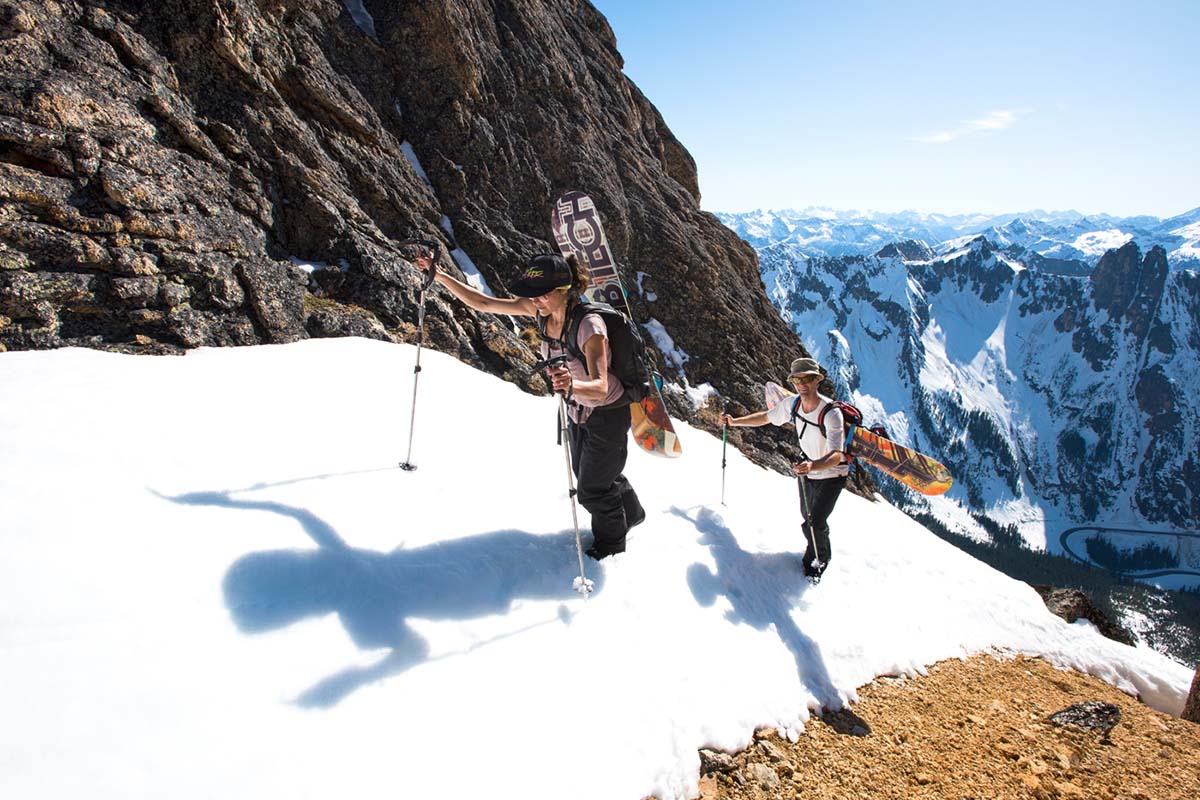
A final alternative to splitboarding is learning to ski. If you are a beginner snowboarder or not particularly attached to the sport, skis offer a few tangible benefits. Most notably, they’re more efficient on the uphill, offer quicker transitions (no need to assemble a board or move bindings around), and are easier to ride and maneuver over flat terrain. To be sure, splitboarding is an excellent way to travel in the backcountry—and especially in deep powder—but if you’re on the fence and haven’t yet invested in either sport, many consider skis to be the more versatile setup.
The most crucial backcountry tool is education, and we highly advise getting the proper avalanche training before heading out. The American Institute for Avalanche Research and Education (AIARE) offers Level 1 courses that are considered the gold standard among backcountry enthusiasts and give you a comprehensive overview of how to travel safely and use your gear properly, evaluate potential risk, and rescue your partner(s) in the event of a slide. There are a host of other ways to supplement your learning, including books, videos, seminars, podcasts, and more—many of which are free (we highly recommend “Staying Alive in Avalanche Terrain" by Bruce Temper). Backcountry travel can be incredibly rewarding, but it’s important to understand the inherent risks (which are many) and ensure you’re properly equipped before heading out.
Back to Our Top Splitboard Picks Back to Our Splitboard Comparison Table